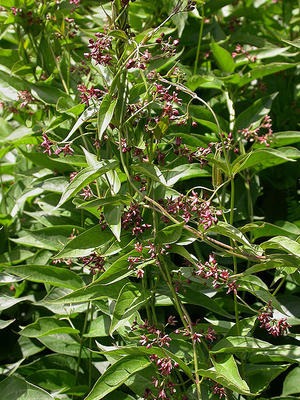Invasive species are non-native organisms that aggressively compete with and displace native species and are the leading source of environmental and economic damage in U.S.
Early detection, control, and education are key in managing the spread of invasive species. TILT works cooperatively as a partner with the St. Lawrence Eastern Lake Ontario Partnership for Regional Invasive Species Management (SLELO-PRISM) to accomplish these goals by educating Stewardship Volunteers to identify invasive species and how to map their location at preserves through the use of iMap. The Stewardship staff then uses this information to eradicate the invasive species if detected early or to manage it.
Pale Swallow-wort, which has been found in significant density on several islands as well as on the mainland, is a long-lived, perennial, twining, herbaceous vine that is a member of the milkweed family. The leaves are oval shaped with pointed tips, 3-4 in. long by 2-3 in. wide, and occur in pairs along the stem. The small five-petaled, star shaped flowers are creamy pink to reddish brown. The fruits are slender, tapered pods, 2-3 in. long by about 1/4 in. wide, that turn green to light brown as they mature. When ripe, the fruits open along the seam and release flattened seeds equipped with a downy parachute that aids in wind dispersal. Growing in clumps of several to many stems, pale swallow-wort tends to form extensive patches making eradication difficult.

Invasives like pale swallow-wort pose serious ecological threats because they choke out desirable native species, disrupt natural succession and alter the physical structure of habitats. Grassland bird presence decreases. Pale swallow-wort also has the ability to modify the soil’s microbial community, displacing native plant species that are adapted to the unique microbial association.
Controlling Pale Swallow-wort is complicated. Eradication is the ideal control, but the plant’s growth habits make that a specialized effort. Chemical herbicides are the most effective control, but require extensive training for safe and effective use. TILT is working with some landowners in the Thousand Islands to control swallow-wort on their properties.
TILT’s Stewardship Coordinator, Brandon Hollis, is a Certified Pesticide Technician, able to apply herbicides used to control Pale Swallow-wort and other invasives. If you’d like more information, visit SLELO PRISM or contact the Land Trust at 315-686-5345, or [email protected].
